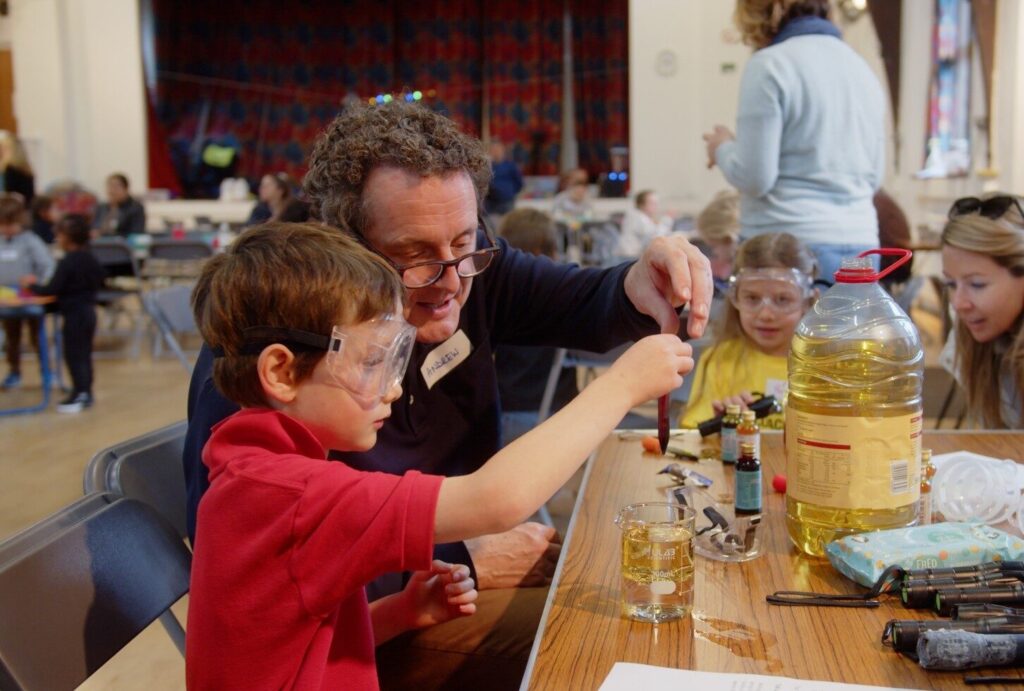Research into Messy Churches in Schools in the UK
Introduction
Throughout 2013 the Messy Church Team in the UK has been exploring some of the challenges and advantages of running Messy Churches in schools. Early in the year a questionnaire was sent out to over 50 Messy Churches registered on the website who stated that they met in their local primary or secondary school. In addition, there have been visits to a number of Messy Churches which run in schools in order to talk to leaders, their teams and those who are part of the new congregations. Later in the year a small number of key Messy Church leaders and schools advisers came to a consultation in order to consider the findings and draw up advice and guidelines for those thinking of setting up a Messy Church in a local school.
You can download this as a PDF from the resources section.
Navigating this document
Introduction
Why run a Messy Church in a school?
Findings from the questionnaires
Some challenges observed in running Messy Church in schools
Insights from the consultation day – with questions to consider
Conclusions – including some guidelines if you are thinking of setting up a Messy Church in a school
Final Comment
Appendix 1 – The Questionnaire
Appendix 2 – Gathered wisdom from the questionnaire of ‘best advice’ for those starting a Messy Church in a school
Why run a Messy Church in a school?
At first glance, there are a number of positive arguments in favour of holding Messy Church on school premises. The facilities are already geared for activity-based learning, with access to toilets and usually a large meeting area or auditorium for the celebration as well as a canteen and kitchens for the meal.Another factor in the UK is that about one thirds of primary schools and a smaller proportion of secondary schools in England and Wales are Church of England schools/academies with some Methodist and a few other independent church-founded schools. As part of the mission of the Church, these schools are being encouraged not only to provide an excellent education for children but also to be an environment within which to introduce children to a lively and relevant experience of the Christian faith. This current renewal of vision with regard to the mission of church schools in the UK includes a drive towards finding ways in which the school’s Christian distinctiveness can be more visible and effective within the local community. Here are some quotes from a recent church schools report:
The Church of England clearly reaffirms that church schools stand at the centre of its mission. It educates approximately one million of the nation’s children in primary and secondary schools, which enables more direct engagement with children and their families than any other contact, including regular Sunday worship… The drive for excellence and effectiveness in church schools is paramount, but not merely because the government says so. The enabling of every child to flourish in their potential as a child of God, is a sign and expression of the kingdom and is at the heart of the Church’s distinctive mission.
In response to parental demand, there may be opportunities for new church schools to be established to offer that distinctiveness within an inclusive community framework.
New approaches are needed to ensure that the Church’s mission is more widely known through schools and is fully understood.(Extracts from the Executive Summary in ‘The Church School of the Future’ report, March 2012)
Regularly in the questionnaire responses and in conversations with leaders, the team have noted that church schools in particular have expressed a desire to embrace Messy Church as one way in which they can promote and demonstrate their Christian mission within community.
Back to top
Findings from the questionnaires
We received an over 60% return on the questionnaires and indeed a number of respondents were pleased to invite us to visit their particular Messy Church. Messy Churches in schools fell into three particular groupings:
Messy Churches which used the school premises at the weekend as a more comfortable and welcoming environment for Messy Church than their own church buildings, which often lacked basic facilities, such as kitchens and toilets and was often no longer at the physical centre of the local community.
Messy Churches which met in the school on a weekday in after-school time. These Messy Churches were able to draw more directly from the children attending the school and they invited their parents and carers to join them for a Messy Church that ran from about 3.15 pm to 5. 30 pm in the afternoon.
Messy Churches which are working more closely with the school and are experimenting with running a Messy Church for particular year groups within school curriculum time. This group was the smallest but was possibly the most interesting and potentially exciting of the three.
All three styles of Messy Church in schools stressed the importance of building on long-term positive relationships with the local school. Typically this has been developed over many years and includes involvement from the church on the school governing board, taking school assemblies, helping in the classroom and with school trips, offering input into RE lessons and providing pastoral and chaplaincy support. In this context Messy Church was seen as a natural and positive development which benefits both school and church equally. The church is able to use a building that is unthreatening and familiar to families and which has all the appropriate facilities for the range of activities at Messy Church; and the school sees this as a way to express its own Christian distinctiveness and mission as well as to facilitate positive involvement with the local community and the nurturing of intergenerational learning and support.
All three styles of Messy Church also stressed the importance of maintaining ongoing positive relationships with the schools, particularly through a good working relationship with the school premises manager, inviting teachers to be involved in the activities wherever possible and caring for the environment of the building by leaving it in a good condition after each Messy Church.
Back to top
Some challenges observed in running Messy Church in schools
From the visits made to Messy Churches in schools, the team noted a number of areas which perhaps balance out all the positive points made above.
The environment of a school is naturally geared towards children. However, Messy Church is definitely not just for children but is intended as in all-age experience; low tables and small chairs subtly create a context that feels to be aimed at only one constituency of Messy Church. It is particularly true if the dining area is used and the tables are arranged in small groups of fixed plastic chairs, for example, which inhibit large family groups meeting with others.
For some adults, schools can be difficult places to enter. Of course, arguably they can be better than many of our churches, but nevertheless they may carry associations, particularly if parents are only used to coming into schools for awkward consultation days or ‘best-behaviour’ special events. The idea that parents and carers should feel able to own the environment as much as the children may be a little difficult for some. On visits to some Messy Churches in schools it was noted that parents and carers tend to hang back even more than usual at a Messy Church and allow the event to become a spectator session with the children at the centre, rather like attending a celebration assembly at the school or a performance by one of the year groups. Alert Messy Church leaders are addressing this issue as best they can, of course, and subtle changes to the environment – for example, the way the chairs are set out or the tables are arranged (particularly the furniture for the meal time) – can make a great deal of difference.
In many Messy Churches in schools, it has been interesting to note that older siblings, who would normally be of secondary school age, did not generally attend the Messy Church. Teenagers and Messy Church are a whole other area to explore, of course, but in this instance it seemed that going back to their old primary school might make things even more difficult. Because of this, the all-age nature of Messy Church is to some extent compromised by being in a school. It will actually only tend to attract the children and their carers who are actively linked to that school already, and other outsiders and indeed those without families who would like to be part of Messy Church feel less able to be present in a school context.
Some Messy Churches in schools tend to meet less frequently – once every six weeks or so (half-termly) rather than monthly – and they also tend to break when the schools are on holiday. Looking long-term, this sort of frequency is arguably not enough to nurture faith and grow disciples. This is, however, also an issue for many other Messy Churches who decide to meet only bimonthly or for special festivals.
Setting up a Messy Church in a school, indeed the setting up of any church plant in a school, also faces the challenge of how the sending church will relate to this fresh expression of church in the parish or district. Even more than for other forms of church, there is some danger that the traditional Sunday church will see the Messy Church as just a feeder for its Sunday congregation, because it is not taking place on ‘proper church premises’. The idea of a special building for doing church properly is very strongly inherent in our Christian community and especially in the national church. Special places are important and indeed it is sometimes difficult not only for those in the Sunday congregation to recognise that church in school is as much church as it is on Sunday – as it is for those in the school to recognise the specialness of a ‘secular’ building, such as a school. Of course, anywhere can be a place to meet with God but often complete newcomers to faith still feel deep down that a proper church is where such an encounter can best occur.
Most of those who responded to the questionnaire and those whom we met face to face all agreed that the monthly setting up of Messy Church in a school can be very demanding. It often needs to happen in a very short time frame, as does the subsequent taking of everything down again at the end, with all challenges of storage and transport – even in many cases the taking away of dirty plates to clean at home because there is no time or permission to do so in the school kitchens! This can be a huge logistical hurdle. Nevertheless, it is one that many seem happy to take on because they feel the benefits of using a school outweigh these inconveniences.
As mentioned above, there are some Messy Churches in the UK that are working in close partnership with their church school and which are running Messy Church within curriculum time. Often this takes the form of one Year Group (30, 60 or 90 children) or Key Stage (two or three Year Groups together) having a dedicated afternoon during the week, once or twice every term, which becomes a Messy Church-style session. Parents and carers are invited to join with that group, including a time of celebration, crafts and usually ending with some sort of eating together. This particular expression of Messy Church in schools does of course have a disadvantage in that it is not a true all-age expression of Messy Church but rather an extended community assembly time with activities for only one section of that community.
Back to top
Insights from the consultation day
In October 2013 BRF hosted a consultation day that drew together a small invited group of professionals working in schools and with Messy Church. The discussions on that day built on the findings above and a number of key issues and questions emerged.
Key questions from the conversations:
Is there a danger that a Messy Church in a school creates a tension between what is worship and what is learning?
Doesn’t the success or otherwise of a Messy Church in a school depend hugely on whether that school already sees itself as a worshipping community?
Is it appropriate to be confessional in a school setting?
Isn’t the integrity of the Messy Church brand at risk of being diluted because, by virtue of it being in a school, it is likely not to be all age and open to all, even though it may aspire to be both?
Would it not be better in many cases to talk of a messy event taking place in a school rather than calling it Messy Church?
If the real aim is to reach a community, then might a focus on holding the Messy Church in the school building be unhelpful? In other words, it is essential to listen to the needs of the community rather than assume that Messy Church in the school is the solution.
The cooperation and endorsement of a head teacher is essential to anything delivered on school premises. A Messy Church in a school that hopes to reach that school’s community needs to build on long-term, mutual and positive relationships between the church and the school. It was noted from the questionnaire responses that it seemed some Messy Church teams had never considered either what they bring to the school or what the school gains by having a Messy Church in its building.
Surely the key question to consider should be ‘How can we best serve the school and its community?’ Sometimes the answer may well be not to run a Messy Church in the school.
When is a Messy Church not a Messy Church? If there is no proper meal at the Messy Church in a school, is it Messy Church? If it isn’t all-age, is it a Messy Church?
Why are there not many (if any) Messy Churches in secondary schools?Can a Messy Church in a school help children and young people grow up into faith through the transitional stages that schools inevitably impose? Can we be working more closely with traditional youth organisations to address this within Messy Churches in general?
Back to top
Conclusion
So how can we best advise the people of passion who want to run a Messy Church to consider whether a school venue is the best option?
The following series of observations may help:
It’s easy to put on a messy event, but do we really want to be a Messy Church in the school with all that is implied by being church?
Are we in this for the long-term (that means, to make disciples) and can this happen at a Messy Church in a school?
Look carefully at the advantages and challenges of holding a Messy Church in a school as outlined in this document.
Consider carefully your relationship with the staff and notably the head teacher of the school. A Messy Church can hope to flourish only where there is a shared vision and ownership of this mission to the community.
Think carefully about what this proposed Messy Church offers that genuinely serves the school.
Consider how a Messy Church in a school can not only enhance the general curriculum but also support the hidden curriculum, including the spirituality of the school and its community relations, with affective learning and worship.
As Messy Church leaders, make sure the focus is on the school community, not just the building.
Check and double-check that you have genuinely listened to the voices of the community as the first step in any vision for setting up a Messy Church. Ask just where the best place in this community is for a Messy Church to happen, given the core Messy Church values.
Does everyone involved understand and own what Messy Church is – that is, the particular distinctive of being all age, Christ-centred, offering hospitality, creativity and celebration. This is important not only so that the ‘brand’ is protected but also so that schools can be sure what Messy Church actually is when it is proposed to them.
Back to top
Final comment
The Messy Church model is of course very attractive and already has a number of recognised off-shoots, which, although not being Messy Church per se, are legitimate add-ons, follow-ups or preparations for Messy Church. It could be that much of what happens or could happen in a school falls more comfortably into this category, such as Messy lunch-time clubs, Messy (after-school) clubs, Messy prayer spaces or Messy moving-on clubs. Parents and children from a school community could even have Messy school meet-ups, praying for the school and/or supporting each other on their journey of faith. In other words, different models of mess could happen in schools, and need to be considered as any church addresses the key question: what might ‘church’ for the school community look like?
Back to top
Appendix 1
These were the questions sent round to Messy Churches running on school premises.
Please could you briefly describe your setting: for example, small church, school of 400 children, urban, rural, church-aided school, and so on.
How long has your Messy Church in school been running?
What prompted you to work with your local school in this way?
Was it a church initiative or a school initiative?
How would you describe the relationship between the school and church before Messy Church? And now?
How often does the Messy Church meet?
Please provide a simple description of the shape your Messy Church gathering takes (for example, activities, celebration, meal)
Do you run your Messy Church on school premises after school hours or is it in curriculum time? Why did you choose to run it at this time?
Roughly how many adults come? How many children? Of what ages? More boys or more girls? How many school staff?
How do you manage to provide the ‘eating together’ element of Messy Church?
What advantages have you found in holding Messy Church in the school rather than in a different building?
What challenges have you faced about running Messy Church in the school rather than in a different building?
What benefits does the school see in having Messy Church?
What benefits does the church see in having Messy Church?
What three bits of advice or warning would you give another group thinking of setting up Messy Church in a school?
Have you any anecdotes or stories to share from your experience of running Messy Church in a school?
Is there anything else you would like to add – new initiatives, questions or thoughts?
Back to top
Appendix 2
Finally, here is a selection of the questionnaire responses to question 15, which asked for the best advice for those thinking of starting a Messy Church in a school.
Do not be discouraged by a slow start. I think this applies to all Messy Churches. Use the gifts you have within the team and be aware of the team’s limits while being alert to the gifts that are ripe to be developed.
Establish good relations with the school including, head teacher, caretaker, kitchen staff and so on.
Advertise through book bags (which the children take home).
Think through how you use the playground. Will it be out of bounds? Who will supervise the children if they are using the climbing apparatus? What happens if the older boys are playing football?
Relationship with the head is key. Know clearly from the outset the expectations from the school. Communication with the parents/PTFA asking them how Messy Church could benefit them.
Messy Church, wherever you choose to run it, needs a strong and committed team. I would suggest you need at least ten people and ideally more!
Ours has been successful because of more than two years of building relationships with families that happened before. People came because they knew and trusted us.
Communication with the school is key. Act quickly to iron out any difficulties.
You need a good group of volunteers – particularly people who are good at interacting with children and doing craft activities.
Preparation time to run the Messy church session is often longer that the session itself.
Respect the school and do not stray into areas you have not been invited to use – clear up after yourselves including emptying the bins! Leave the school as you would wish to find it.
Make sure the head teacher and the caretaker know what you are doing – make the caretaker your friend.
Look out for ways to help the school. Join in with things they are already doing – don’t push it!
The sending church needs to be committed to what they have agreed to do or else you will let the school down.
Follow your heart, have a passion for spreading the love of Jesus. If God is in it, it will succeed. Go for it, it is great fun and especially reaches out to non-church folk. Good relationship with the school is essential.
It does take up quite a bit of time. We have a planning meeting once a month and most of us spend a lot of time at home thinking up themes and preparing activities. That’s nothing to do with being in a school, though! Don’t take the school for granted; ‘thank you’s and boxes of chocolates go a long way. we have been so lucky in the cooperation we’ve had from school. Oh yes, CRBs. Have to follow strict school rules. Use the toilets they say you can use and don’t let the children go running round the building, even though it’s their school.
Find a good way to advertise.
It is important to have a good relationship before you start. We have one teacher who organises the events each term and it is great having just one person to be able to contact and assist with communication.
Think carefully about the age group you are going to have and adjust accordingly. Give the teachers easier stations they can pick up quickly, for example, refreshments, and leave more biblical content stations to one of the church leaders/helpers.
Try to show the school the benefits of doing a Messy Church in their school (as a way of meeting their targets and curriculum). We are thinking about taking our Messy Church plans to our other local school and see if they would be on board for something similar. The school does need to be on board with the sessions as they do write letters to the parents re. the events with information and so on.
Know who you are trying to reach; if you want the whole family, consider weekends.
Don’t think of Messy Church as something that stands alone in your relationship with the school; think of how else you might work with the school.
Be realistic about what activities you can do in someone else’s space. On the day have a team small enough not to overwhelm people but large enough to allow time to build relationships.
Work with the school and head, but do not expect the staff to help run the activities – they find it too stressful to occupy a different role to being ‘teacher’. You do need a large group of willing volunteers, especially as not everyone can be available each time (most of mine are grandparents or of that generation). We find that providing between six to eight activities works best to keep the families occupied and each one ideally needs two helpers to run. You also have to work at getting the adults to join in and not just sit at the edge observing, both for the activities and the worship/celebration.
Think about how it will be financed. We have donations, but they don’t always cover all the costs. We are very fortunate because our school doesn’t charge us for using the premises.
A good relationship between school (mainly the head and caretaker) and church (mainly the leader) is vital for this to work well.
Think of it as a new congregation (fresh expression). This is unlikely to increase your congregation on a Sunday, but we have found families are more likely to come to special services such as crib service, Christingle, and so on, and we do hold a Messy Church on Good Friday in the church or village hall.
Keep constantly talking to the head teacher and governors. Talk when things are going well. Come in the day after to make sure everything was left OK. Remember it is their school, not yours.
Be flexible – schools have things they must do, and there will be times when they need to move you around. Go with it – remember that you are helping them meet their needs and provisions; they are not just a good source of children and families, but their own community with their needs too.
Encourage the school to see Messy Church as one of their activities, run by you. This will enable them to publicise you in their material, talk about you to other schools, and be proud of you.
Ensure good relationship with the school and maintain it.
Have team members who are also parents at the school.
Be prepared for the hard work in transporting equipment, setting up/taking down.
Take time to pray about where God is leading you.
Build relationships with school staff, especially the head (we have done that through assemblies, and so on).
Think seriously about whether the venue really matters to the families who will attend.
Involve parents in delivering the snacks, crafts, and so on as soon as possible. Build a team from within as it’s hard work and not sustainable otherwise.
The BRF Messy Church Team January 2014
Back to top
You may also like

Creating Safe Spaces
25th Nov 2024As our media fills up with stories of abuse and coverups within religious organisations, it was very timely that children and family ministry denominational leaders met to discuss ‘Safeguarding’ at the Children’s Ministry Network Conference November gathering at High Leigh Conference centre.

Woman at the Well
3rd Nov 2024After a busy 3 day of leading seminars, networking, and being on the Messy Church stand at Church of Norway conference, I had the opportunity to visit a sauna, called The Well, Oslo. It’s the Nordic region’s largest Spa in Scandinavia, with baths, saunas and spa treatments from all over the world.

Seaside Sojourn
21st Oct 2024It seems that I always get booked to deliver in-person training at seaside locations. This trend continued last weekend, as I headed off to the coastal village of Seaton, Devon.

Our Survey Said…
7th Oct 2024Back in February 2024, Church of England kindly sponsored a survey, completed by 330 Messy Church leaders. This is what we...

